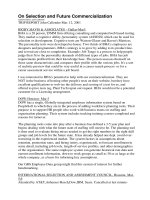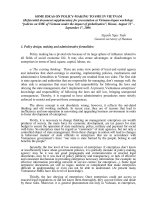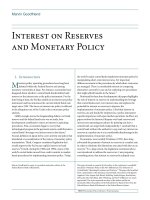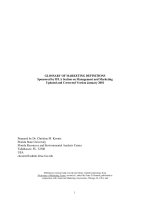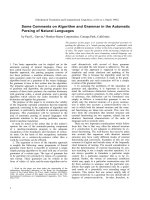Some viewpoints on science and technology reform: Issues to be considered when making science and technology policy
Bạn đang xem bản rút gọn của tài liệu. Xem và tải ngay bản đầy đủ của tài liệu tại đây (204.17 KB, 13 trang )
Some viewpoints on science and technology reform:…
24
SOME VIEWPOINTS ON SCIENCE AND TECHNOLOGY
REFORM: ISSUES TO BE CONSIDERED WHEN MAKING
SCIENCE AND TECHNOLOGY POLICY
PhD. Student Nguyen Thi Phuong1
National Foundation for Science and Technology Development
Abstract:
Science and technology (S&T) always plays an important role in and is a driving force of
socio-economic development of each country or each region, especially in the presently
default knowledge economy. By a synthesis approach, this article presented views or
management models of S&T which had been drawn from research findings by
organizations and experts worldwide. Discussions and proposals in this article relating to
S&T research highlighted the role of basic research in promoting the world knowledge
economy and expected that it would create a platform to facilitate the determination of
direction and identification of issues need to be considered when making reform of S&T
policy in Vietnam, which was found still limited in the context of international integration.
Keywords: S&T policy; Science, technology and innovation (STI); Basic research.
Code: 16031601
1. Introduction
In the trend of mankind development, in general and the knowledge
economy, in particular, most of the nations in the world have put high
interest and attention in increased labor productivity through STI
development. Accordingly, the competitiveness of a country is directly
dependent on innovation capacity and the ability of exploitation of
enterprises’ research results for production and social development. In this
context, the development of policies for STI plays an important role.
In Vietnam, the capacity of STI was still low and the national innovation
system was still limited. Research and development (R&D) was still a
complementary activity implemented in enterprises and government
agencies2. These limitations were also reflected in the ranking table of
global competitiveness in 2015, where Vietnam ranked 56th out of 140
countries (VEF3, 2015). Recently, in the Bloomberg ranking of 50 countries
1
The author’s contact at
2
Evaluation report on STI in Vietnam by OECD (provided by World Bank in 2014)
3
VEF: Vietnam Education Foundation, />
JSTPM Vol 5, No 2, 2016
25
considered as the most innovative nations in the world in 2015, Vietnam was
not present in the list, and in the Global Competitiveness Report 2015-2016.
In recent years, Vietnam has worked hard in S&T development in order to
enhance national position. However, in the context of international
integration, there is a need to increase competitiveness of knowledge
economy, whereby some important factors were considered as barriers to
the development of STI. These factors should be addressed in the near
future. So this will need to have specific provisions from STI policies to
match properly with the socio-economic development.
During the past, some experts expressed their views at many different angles
on the role of STI policy for socio-economic development. In this article, the
author provides an overview of some viewpoints to serve as the basis for
analysis of factors affecting the process of formulation of STI policy in order
to promote this activity for socio-economic development in Vietnam.
2. Significance of STI policy for socio-economic development
In terms of the viewpoint on innovation system4, David P. and P. Dasgupta
(1994) said that the modern knowledge economy had three key growth
objectives:
- Increasing labor productivity, promoted growth;
- Enhancing research capacity;
- Promoting the establishment of funding models in the form of public
research funds.
In which models of public research funds were formed on the basis of:
- Risk taking and sharing when funding for scientific research activities;
- Development
awareness;
of
knowledge for communities,
raising people’s
- Promoting the combination of research and the need of society.
Sharing with that same perspective, Syanbola et al (2014) analyzed relevant
issues of STI policy in relation to the application of scientific research
results. The authors reviewed the issues in view of the tripartite model5
(Triple Helix) which set out three key questions:
4
Freeman. (1987) Innovation System is a network of organizations in the public sector and private sector whose
activities and interactions initiate, import and dissemination of new technologies.
5
Triple Helix "the tripartite model of partners", namely Enterprises - the business community or the owner of
innovation; Research institutes and universities – the knowledge producing institutions, backstopping for
26
Some viewpoints on science and technology reform:…
- How to have a good policy for STI development to facilitate the human
and material resources development for socio-economic development?
- How to develop STI policy appropriate with national conditions and
make confirmed the major role of STI in national socio-economic
development?
- How can develop STI policy consistent with the national priority
programs and be also effective measures to create scientific,
technological, innovative products based on knowledge, ideas and
strategies for sustainable development?
The Millennium Development Goals at the World Summit on Sustainable
Development, the new partners for Africa development and report by a
number of experts with an international consensus on the reference frame
for S&T plan in Africa. Scholars have examined the applicability of
researches under this frame through their transparency, accountability and
fairness. In which, it included good governance and success indicators of
the latest efforts to develop and implement STI policy.
In view of innovation system, some other scholars also had given the same
opinion such as:
Bo Carlsson et al (2002) introduced the concept of technological innovation
system, in which the author described the components of this system
including the interactive actors in a specific technology at infrastructure of
a particular organization related to the creation, dissemination and use of
technology (Carlsson và Stankiewicz, tr. 49).
While some other experts like Michael Gibbons et al (1994) emphasized on
social benefits and knowledge production institutions at the micro level
which need a specific historical context, the viewpoint of tripartite partners
was concerned on aspects of how to convert academic knowledge into
practical applications for economic benefits. The view of tripartite partners
showed the role of each party to play, in which enterprises were key players
in STI as they were implementation agent of innovation, while the State
was responsible for creating an enabling environment where innovative
products by scientists were closely guarded, so scientists could fully be
assured with doing research and disseminating widely their creative ideas to
the public. Again, it could be confirmed that the individual relationship and
independent role could not be maintained its optimal role in promoting the
tripartite model of the Triple Helix.
innovation process with new knowledge and ideas; and Government/State authorities supporting for innovation
process through state funding or technical support.
JSTPM Vol 5, No 2, 2016
27
Padilla-Pérez, R. and Gaudin, Y. (2014) provided other examples relating
to STI policy in practice, i.e, important issues need to be early identified
(priority) during developing S&T plans as the development of S&T would
bring what a nation expected to achieve. Latin American countries used to
seek to develop projects integrated from foreign direct investment sources,
technology transfer and import substitution was undertaken. The group of
these countries also made comment on possible policies immediately
created after the testing phase and during the belt tightening due to debt
crisis. The view of this group was shown in their national system under
innovative approach and it was said: "The government plays a central role
in the innovation system through two main activities
Firstly, actions towards new knowledge dissemination through public
research centers, universities and businesses.
Second, actions towards adjustment of laws, regulations, policies to support
STI activities, including provision of funding" (p.750).
From the above perspectives, the study team found that the formulation of
STI policy based on the starting point of assessing relationships affected the
tripartite relationship (enterprise - research institutions/universities Government/State) by policies, at the same time, pointed out the importance
of identifying prioritized research issues in S&T relevant to the social needs
and context of each country.
Unlike the views on giving priority for basic research, Gibbons et al (1994)
mentioned a lot to research management. He and his colleagues showed a
change in the production of interdisciplinary knowledge, two modes of
knowledge production mentioned by Gibbons et al were, as follows:
Table 1: Characteristics of new knowledge production by Gibbons et. al (1994)
Mode 1
Mode 2
Entities of
knowledge
production
Universities, research
institutes, enterprises
and national
laboratories...
Centers, networks, projects with
participation of actors from various
organizations such as universities,
firms, public sectors/areas.
Knowledge
creation structure
Monophyletic
Interdisciplinary/interference areas,
multidisciplinary or interdisciplinary
Resources (Source
of problem
formulation)
Researchers
Researchers collaborating with other
stakeholders
Quality control
Independent evaluation
Peer review combined with other
practices such as assessment of
impact on and benefit of the parties
concerned.
28
Some viewpoints on science and technology reform:…
Both modes of new knowledge production have prevailed in scientific
research and are mutually dependent. The legitimacy of STI policy is now
based on a number of assumptions such as the need to adjust governance
issues of scientific research to promote the accountability of science to
society and the active participation of scientists. However, mode 2 showed
a clear trend of transformation of new knowledge of scientific research, and
it had much influence on policymaking community worldwide for STI.
However, deeper arguments were indicated in the document "Production of
new knowledge" where included all the parties involved in the formulation
and survey of research questions collected from other studies and policy
making parameters.
Besides the above arguments, Triple Helix by outlining the views of
Etzkowitz Leydesdorff and Henry (1998) made the comment that, models of
knowledge-based innovation was really emerging in most developing
economies in the Organization for Economic Co-operation and
Development (OECD). Triple Helix considered that the interaction between
elements of knowledge with social benefits was important and confirmed
that the interaction did not derive from the separation of academic science
areas in the face of current social context.
By the end of 1980s, there is some gradual change in parameters of the
concept to legitimize or justify the approach of STI policy. The key issue
was the switch from a linear policy approach to logic thinking (the first
generation of science policy was based on the assumption thinking by
dividing sciences to produce knowledge and the application of knowledge
was for enterprises in society). Some countries kept this view because they
thought moving from a linear approach in most countries was only a
formality rather than reality (linear model supports two approaches of STI
policy, whereby technology and innovation policy was separated from
science and research policy).
Thus, viewpoints on knowledge production have exposed the idea that in order
to renew policies, it should start from adjustment of the scientific research
management, as the process of scientific research is the process of direct new
knowledge production, the motive force for innovation. The process of
producing new knowledge actually is the nature of basic research in science.
3. Some issues related policy
3.1. Setting priorities for STI development
In reality, policy makers must take into consideration those issues to be
given priority to select specific outputs, choose which type of research
JSTPM Vol 5, No 2, 2016
29
focused in the development strategy. However, there has not been more indepth studies on this issue, except within some sectors. Priority setting is
not fixed, but it needs the connection between the priorities established with
the policy objectives and the evaluation of the outcome. This indicated that
there was little research or policy efforts conducted to set priorities in recent
times. Setting priorities was one of the important tasks of STI policy.
Setting priority is a decisive factor in determining the expected outcomes,
possible tools, instruments and funding methods to be used.
In the past two decades, OECD countries were increasingly interested in
this issue to assess scientific research, but so far, there has only been a few
of priorities set out. The most recently recognized priority setting was the
advancement of the Lund list in global challenges which was lately
integrated into the Horizon 2020 program. Horizon 2020 was a program of
successful research topics and actions by the Seventh Framework Program
of the European Union for research and innovation. Accordingly, it
provided the classification method for different models of setting priorities
for research and innovation. The authors had identified the following
priority setting:
- Increased the profit in public investment in research;
- Increased the relevance of research with socio-economic objectives
(competitiveness, growth, welfare, etc.);
- Linkage between research with long-term goals of society.
Considering this perspective, priority setting became a resource allocation
issue and the development of tools, funding modalities to administer the
factors in the system to ensure that the results achieved as expected. Das
Gupta and David (2004) had identified 5 key questions should be answered
when dealing with priorities setting, namely:
- What are the priorities of public investment?
- How to make the S&T development prioritized?
- What mechanism to be used to set priorities?
- How is the decision making process?
- Who are the stakeholders involved?
These questions will help establish an applicable classification to determine
the investment priorities for S&T, independently on the development
situation of the country. Accordingly, the authors showed the effort to set
priorities in accordance with the output published from a number of
different countries in the OECD bloc.
30
Some viewpoints on science and technology reform:…
Besides, there ware opinions that, priority setting can be used to avoid
wasting in research spending. This lesson was drawn from the health sector,
where priority setting was used quite popular. Iain Chalmers et al (2014),
who presented a classification table of research purposes, which pure basic
research (to expand knowledge), pure applied research (to immediately
increase the application of research results and policy decisions into
practice), and use that as motivation (inspired use) for basic research (both
expanded knowledge and increased application).
The problem was identified by Chalmers et al, i.e basic research
traditionally received the lion share of research funding, but its contribution
to health improvement or creating motivation for basic research was less
than applied research. The authors showed how to avoid wasteful spending
in research, as follows:
- Make more investment in scientific research;
- Ask donors to provide a systematic overview of what has been known
and the previously funded projects to determine the new investment;
- Develop those programs that help figure out the best potential scientists
and be proactively implementable;
- Promote interdisciplinary research work.
Although these results were found by the authors from the health sector
database, the parameters outlined here can be applied to general policy on
STI.
One of the basic results of STI policy is providing knowledge to improve
policies in other areas. The integration of concerns at macro-level like
health care equality with other sectors to determine priority setting.
Accordingly, Henry Etzkowitz and Loet Leydesdorff (1998) gave a detailed
overview of the inputs necessary to establish such priorities. The arguments
presented by these authors have demonstrated two important issues: first,
the importance of setting priorities for developing countries; second, the
possibility of cooperation among countries to improve the quality of these
issues.
An example of a well-known method for setting priorities: surveying and
forecast mapping. Survey was received attention because it was conducted
by the European Science Foundation and was different from the standard
survey method which applied for identify priorities for scientific
development rather than for technology. Survey was to create the effects of
decisions today to get a better future, for example for technology
development, for society or for science. European Science Foundation
JSTPM Vol 5, No 2, 2016
31
proposed that the survey methodology also can be applicable to science
development to optimize research funding or conduct strategic recruitment.
Surveying sciences can be applied to select strategic areas for investment
strategy of the country or of public research institutes. This report also
provides a series of minimum conditions to conduct a survey of sciences
and some key differences between survey on S&T areas. Marie L. Garcia
and Olin H. Bray (1997) not only focused on forecast mapping technology
but also provided an example of how this technology was used in business
environment. The techniques of setting priorities such as survey and
forecast mapping (road-mapping) were widely used in business
environment and were implemented by companies, e.g Shell and British
Petroleum. According to the authors, the forecast mapping technology was
the most useful in situations where "decision on technology investment is
made not in a linear manner”. This can happen as a result of competitive
technologies or where it is not clear to pursue or do replacement (e.g, to
improve existing technology or to replace with a new technology), or
undertake necessary cooperation to develop or acquire technologies.
Forecast mapping technology is used to facilitate the technology planning
and application at sectoral level, e.g the transformation or development of
technology in transport, agriculture, energy sectors, etc. Garcia and Bray
provided an overview of the participatory process in forecast mapping
technology from the identification of technology or technological change
alternatives, assessment of current situation. Trend of forecast mapping is
realized for each technology. For example, if an energy Enterprise X
invests in free-carbon technologies and decides to use forecasts mapping
technology for this issue, then it will need to create a roadmap for each
potential technology that needs to consider. Therefore, forecast mapping
technology requires significant knowledge about selection of alternative
technologies or access to information sources such as universities or
national laboratories.
Thus, as experts pointed out that to build STI policy, it needed to set out
priorities, priority setting was conducted through the knowledge on the
S&T system. Through survey and S&T forecast mapping, policy makers
would have an accurate assessment of the need for S&T development
appropriate for specific socio-economic context of each country.
3.2. In terms of funding tools and methods
Study on funding tools and methods showed it was considered as a key
issue to steer the research in the donor driven direction. One of the most
popular trends of STI policy today is the transition from block allocation of
funding to competition based allocation between organizations and
32
Some viewpoints on science and technology reform:…
individuals. This change has been proven by a scientific basis as how much
a business spends money and it thus requires more effort to ensure
accountability to the community. Moving to competitive allocation is also a
part of the overall change towards putting science into the national
framework of competition, whereby universities are under the global
ranking and increased scientific workforce competitiveness among OECD
countries. While there are many benefits obtained from this approach, the
other factors depend on the nature of S&T system, but the two issues are
invariant. Competition based allocation requires more knowledge and more
costly than block funding for organizations. The evaluation of aid
effectiveness in scientific research has consolidated scientific basis for the
allocation of resources for scientific community. The criteria used to
evaluate research performance usually include total published works, the
impact of research on socio-economic development.
Diana Hicks (2012) touched upon the dealing with funding and research
methods issues. In her paper, Hicks focused on the evaluation of the
efficiency of national funding for research based on effective funding for
university research. The paper presented an overview of the approach at
national level for funding research projects based on efficiency calculations.
Hicks defined a performance-based funding system was the one should be
assessed through peer-review. A research assessment must be done in early
stage (expost). Review of proposals for funding research projects or
programs never includes post evaluations (exante) (tr. 252).
Jacob, M. and Meek L. (2013) showed an overview of funding tools and
methods for research. In which, financing tools were arranged to allocate
research funds to groups, individuals and organizations, the arrangement
was actual in accordance with practical funding instruments. Therefore, a
project was a funding instrument, but it should comply with rules and
procedures governed by donors and their advice on what funding methods
can be used. The rationale for this was because there was only a limited
number of tools available for research funding, while the financing method
was important for the strategic development and management of research
funding as they determined the management cost and allocation of funds.
Through funding methods, donors can communicate and manage in more
updated way to promote the output of a specific system.
Sarah C. (2005) and Heinze T. (2008) provided an example in Brazil, when
putting the question of how to solve difficult problems when developing
STI strategy in developing countries, for instance, connecting research with
local issues and how local scientists handle with technologies. Sa C.
described sectoral funding and analyzed the difficulties encountered in the
cooperation between universities and businesses.
JSTPM Vol 5, No 2, 2016
33
In India, scholars found that the main objective of S&T policy was to
promote excellence research centers. This concern has been perceived by
OECD countries to consider as how to promote/support this kind of
research centers.
Heinze T. put forward the idea of research fund and analyzed the context of
funding research projects. Thereby, risky projects was identified due to the
two following causes:
- The project is not feasible due to low allocated funds and short-term
investments;
- The bias existed when reviewing the proposal (inaccurate evaluation
mechanism may increase risks to the project).
Heinze T. (2008) pointed out that the selection of programs for funding was
a breakthrough step. He noticed, long-term funding mechanisms were more
favorable for interdisciplinary or explorative research. Heinze also assumed
that donors should boldly propose to develop funding tools and methods for
diversified researches appropriate with research groups or projects.
From the above points of view, it could understand that to have good
projects, it should have appropriate funding tools and methods. Through
these tools and methods, the selection of policy evaluation face two main
challenges in respect of research funding, namely: (i) creating tools and
methods that support good combination of applied research and explorative
research; (ii) finding ways to conduct simulation studies of existing
problems in society but still limited in science.
3.3. Globalization and international cooperation issue
When observing at STI policy in the current global context, it can be
noticed that globalization and international cooperation issue is one of the
top priorities of most countries. Two issues of concern include the
movement of students and high-skilled labor resources, and the
coordination of donor agencies in research and development cooperation.
One of the main trends of contemporary STI policy is the increasing level
of international cooperation. Globalization is always an important issue of
higher education with research focus on the trend of recent innovation, as
the movement of scientific manpower is inevitable for every country under
the increasingly stronger integration with the world. Many national research
councils are teaming up in research such as the European Research Area,
abbreviated as ERANETs), or the creation and innovation program called
"Joint Programming Initiatives”. However, the current research cooperation
is a major challenge for many developing countries, so it should have a
34
Some viewpoints on science and technology reform:…
research strategy done to quickly achieve as highest benefits as possible.
Pastries Boekholt et al. (2009) and colleagues pointed out a comprehensive
overview of the process of international cooperation in research. Research
cooperation is classified into two types: wide and narrow STI cooperation.
Broad STI co-operation is meant to increase the amount of foreign
investment into a country by many different ways to achieve major
intended objectives. Narrow STI cooperation is meant to make investment
for specific goals, such as promoting or attracting international academic
scientists; enhancing the effectiveness of science and strengthening the
realization of the set objectives.
According to Jacob M. and Meek L. (2012) said that one of the ways used
by countries to deal with the pressure of globalization was to promote
policies for higher education and research, emphasize the issue of scientific
workforce movement. The authors provided an overview based on the
analysis of scientists through policy instruments to promote capacity
building and international approaching. Movement of scientific personnel
was the combined trend when scientific human resources were identified as
scarce and tended to concentrate in major centers. Heitor et al (2014),
defended the view that it should give priority to attract highly qualified
scientific manpower and place in important positions in economic
development as this development was dependent on the attraction of highly
qualified scientists.
Heitor et al (2014) also stressed that countries need to focus on and select
“what priority action and to take appropriate decision” so as to increase the
use of investments for education, there should be policies to attract
scientists to foster and promote talents. Many developing countries were
warned that investing in higher education and scientific research, but there
was a tendency of highly qualified scientists remained in large institutions
of some Westen countries. The controversy stemmed from the data in
Portugal, when Heitor and colleagues said that it could retain talents in the
country if a long-term strategy and investment was selected for sustainable
science. Investment portfolios are diversified by funding instruments and
investments in research, at the same time, it confirmed the role of funding
and financing methods indicators nationwide.
Jonkers, K. and R. Tijssen (2008) provided an analysis of the relationship
between human movement in science and international cooperation by
investigation focused on Chinese scientists living in US. Jonkers and
Tijssen provided actual data to demonstrate the changes outlined in the
Jacob M. and Meek L. (2012) when assessing the need for a strategy to
ensure the return of the scientists and the readiness to participate in
international cooperation network.
JSTPM Vol 5, No 2, 2016
35
Thus, the factor of globalization and STI policy indicated two key elements,
i.e globalization and international cooperation. These issues should be
taken into account by STI policy with a view to promoting and sustaining
research capacity in research community in each country. The attention to
globalization and international cooperation is a matter of confirming the
potential of STI in each country.
4. Conclusions
Based on the analysis of the viewpoints of some experts, this study showed
three important elements for policymaking of STI, including:
- Setting policy priorities for scientific research in connection with
economic development and social needs;
- The formulation of policies for reform of S&T management should be
considered based on the linkage of scientists, research institutions and
enterprises in the innovation system, at the same time, placing the
emphasis on research cooperation under global integration context;
- There should be a reasonable choice of funding tools and modalities to
be appropriate to each research model.
The overview and analysis in this article will contribute to support the
development of policies for reform of S&T management in the near future
in Vietnam./.
REFERENCES
1.
David P. and Das Gupta P. (1994) Towards a new economics of science. Research
Policy 23 pp. 487-521
2.
Michael Gibbons et al. (1994) The new production of knowledge: The dynamics of
science and research in contemporary societies. Sage.
3.
Marie L. Garcia and Olin H. Bray. (1997) Fundamentals of technology road-mapping.
Albuquerque, NM: Sandia National Laboratories.
4.
Etzkowitz, Henry, and Loet Leydesdorff. (1998) The endless transition: a 'Triple
Helix' of university industry government relations. Minerva 36.3, pp. 203-208.
5.
Bo Carlsson et al. (2002) Innovation systems: analytical and methodological issues.
Research policy 31.2, pp. 233-245.
6.
Sa C. (2005) Research Policy in Emerging Economies: Brazil’s Sector Funds.
Minerva 43, pp. 245-263.
7.
Heinze, T. (2008) How to sponsor ground breaking research: a comparison of funding
schemes. Science and Public Policy 35, pp. 202-218
36
Some viewpoints on science and technology reform:…
8.
Jonkers, K. and Tijssen R. (2008) Chinese researchers returning home: Impacts of
international mobility on research collaboration and scientific productivity.
Scientometrics, 77 pp. 309-333
9.
Patries Boekholt et al. (2009) Drivers of International collaboration in research. Final
Report 40.
10. Diana Hicks. (2012) Performance-based university research funding systems.
Research Policy 41.2, pp. 251-261.
11. Jacob, M. and Meek L. (2012) Scientific mobility and international research
networks: trends and policy tools for promoting research excellence and capacity
building. Studies in Higher Education, 38(3), pp. 331-344
12. Iain Chalmers et al. (2014) How to increase value and reduce waste when research
priorities are set. The Lancet 383.9912, pp. 156-165.
13. Heitor Manuel, Hugo Horta, and Joana Mendonça. (2014) Developing human capital
and research capacity: science policies promoting brain gain. Technological
Forecasting and Social Change 82, pp. 6-22.
14. Padilla-Pérez, R. and Gaudin, Y. (2014) STI policies in small and developing
economies: The case of Central America. Research Policy, 43 pp. 749-759.

